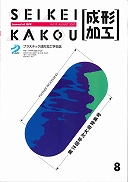19 巻, 8 号
選択された号の論文の35件中1~35を表示しています
- |<
- <
- 1
- >
- >|
目次
-
2007 年 19 巻 8 号 p. Index8_1-Index8_2
発行日: 2007/08/20
公開日: 2021/02/25
PDF形式でダウンロード (574K)
巻頭言
-
2007 年 19 巻 8 号 p. 453
発行日: 2007/08/20
公開日: 2021/02/25
PDF形式でダウンロード (609K)
第 18 回年次大会特集
第 18 回年次大会の報告
-
2007 年 19 巻 8 号 p. 454
発行日: 2007/08/20
公開日: 2021/02/25
PDF形式でダウンロード (751K)
特別セッション
-
2007 年 19 巻 8 号 p. 455
発行日: 2007/08/20
公開日: 2021/02/25
PDF形式でダウンロード (853K) -
2007 年 19 巻 8 号 p. 455-456
発行日: 2007/08/20
公開日: 2021/02/25
PDF形式でダウンロード (863K) -
2007 年 19 巻 8 号 p. 456
発行日: 2007/08/20
公開日: 2021/02/25
PDF形式でダウンロード (852K) -
2007 年 19 巻 8 号 p. 456-457
発行日: 2007/08/20
公開日: 2021/02/25
PDF形式でダウンロード (859K)
一般セッション
-
2007 年 19 巻 8 号 p. 457
発行日: 2007/08/20
公開日: 2021/02/25
PDF形式でダウンロード (853K) -
2007 年 19 巻 8 号 p. 458
発行日: 2007/08/20
公開日: 2021/02/25
PDF形式でダウンロード (853K) -
2007 年 19 巻 8 号 p. 458
発行日: 2007/08/20
公開日: 2021/02/25
PDF形式でダウンロード (853K) -
2007 年 19 巻 8 号 p. 459
発行日: 2007/08/20
公開日: 2021/02/25
PDF形式でダウンロード (856K) -
2007 年 19 巻 8 号 p. 459
発行日: 2007/08/20
公開日: 2021/02/25
PDF形式でダウンロード (856K) -
2007 年 19 巻 8 号 p. 460
発行日: 2007/08/20
公開日: 2021/02/25
PDF形式でダウンロード (851K) -
2007 年 19 巻 8 号 p. 460
発行日: 2007/08/20
公開日: 2021/02/25
PDF形式でダウンロード (851K)
ポスターセッション
-
2007 年 19 巻 8 号 p. 460
発行日: 2007/08/20
公開日: 2021/02/25
PDF形式でダウンロード (858K)
企画セッション
-
2007 年 19 巻 8 号 p. 461
発行日: 2007/08/20
公開日: 2021/02/25
PDF形式でダウンロード (854K) -
2007 年 19 巻 8 号 p. 461-462
発行日: 2007/08/20
公開日: 2021/02/25
PDF形式でダウンロード (858K) -
2007 年 19 巻 8 号 p. 463
発行日: 2007/08/20
公開日: 2021/02/25
PDF形式でダウンロード (854K) -
2007 年 19 巻 8 号 p. 463
発行日: 2007/08/20
公開日: 2021/02/25
PDF形式でダウンロード (854K) -
2007 年 19 巻 8 号 p. 464
発行日: 2007/08/20
公開日: 2021/02/25
PDF形式でダウンロード (851K)
学会賞選考委員会報告
-
2007 年 19 巻 8 号 p. 465
発行日: 2007/08/20
公開日: 2021/02/25
PDF形式でダウンロード (553K) -
2007 年 19 巻 8 号 p. 466
発行日: 2007/08/20
公開日: 2021/02/25
PDF形式でダウンロード (508K) -
2007 年 19 巻 8 号 p. 467
発行日: 2007/08/20
公開日: 2021/02/25
PDF形式でダウンロード (1355K)
特別講演解説
-
2007 年 19 巻 8 号 p. 468-472
発行日: 2007/08/20
公開日: 2021/02/25
PDF形式でダウンロード (13861K)
第 17 回「青木 固」技術賞報告
-
2007 年 19 巻 8 号 p. 473-475
発行日: 2007/08/20
公開日: 2021/02/25
PDF形式でダウンロード (2098K) -
2007 年 19 巻 8 号 p. 476-479
発行日: 2007/08/20
公開日: 2021/02/25
PDF形式でダウンロード (3277K)
講座―製品機能をアップさせる二次加工技術―接合・融着・多層化技術を中心に―
-
2007 年 19 巻 8 号 p. 480-484
発行日: 2007/08/20
公開日: 2021/02/25
PDF形式でダウンロード (7209K)
日本の大学・試験・研究機関の研究 : 154
-
2007 年 19 巻 8 号 p. 485-490
発行日: 2007/08/20
公開日: 2021/02/25
PDF形式でダウンロード (6065K)
会議・見本市だより
-
2007 年 19 巻 8 号 p. 491-493
発行日: 2007/08/20
公開日: 2021/02/25
PDF形式でダウンロード (3536K) -
2007 年 19 巻 8 号 p. 494-497
発行日: 2007/08/20
公開日: 2021/02/25
PDF形式でダウンロード (4316K)
論文
-
2007 年 19 巻 8 号 p. 498-504
発行日: 2007/08/20
公開日: 2009/01/09
PDF形式でダウンロード (2645K) -
2007 年 19 巻 8 号 p. 505-511
発行日: 2007/08/20
公開日: 2009/01/09
PDF形式でダウンロード (5094K)
ファウンテン・フロー
-
2007 年 19 巻 8 号 p. 493
発行日: 2007/08/20
公開日: 2021/02/25
PDF形式でダウンロード (1437K) -
2007 年 19 巻 8 号 p. 497
発行日: 2007/08/20
公開日: 2021/02/25
PDF形式でダウンロード (1252K)
学位取得者の紹介
-
2007 年 19 巻 8 号 p. 490
発行日: 2007/08/20
公開日: 2023/12/27
PDF形式でダウンロード (946K)
- |<
- <
- 1
- >
- >|
